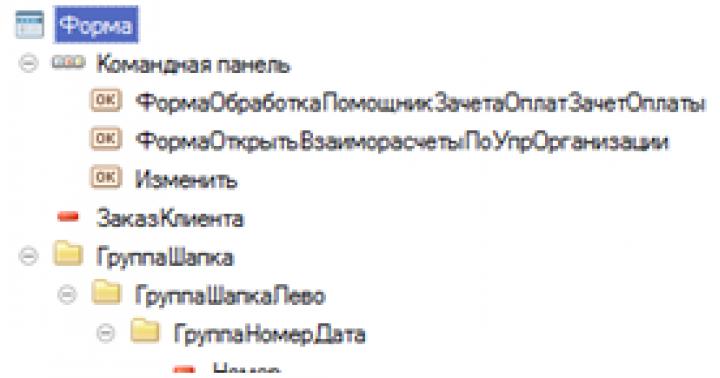General rule multiplication of polynomials says that it is necessary to multiply each term of the polynomial by each term of the other polynomial, and add the resulting products.
But there are several cases when it is not necessary to perform the multiplication completely, but there are already ready-made formulas, called in algebra formulas of abbreviated multiplication of polynomials or simply formulas of abbreviated multiplication.
Formulas
Let's multiply two polynomials (a + b) and (a-b) or in another way multiply the difference of two products by their sum.
Let's use general rule multiplication of polynomials:
(a-b)*(a+b) = a^2 + a*b -b*a - b^2 = a^2 - b^2;
Thus, we get: (a-b)*(a+b) = a^2 - b^2;
This identity is called the difference of the squares of the two expressions.
With its help, we can easily multiply the difference of any two expressions by their sum.
The identity works both from left to right and from right to left. That is, you can write it like this:
A^2 - b^2 = (a-b)*(a+b);
The square of the difference of any two expressions is equal to the product of the difference of these two expressions by their sum.
Difference of squares: examples
This identity should not be confused with another. Here we have the “difference of squares” (a ^ 2 - b ^ 2), and there is also an identity called the “difference square” (a + b) ^ 2.
It should be understood that both numbers and any other mathematical expressions can stand here as a and b.
Consider a couple of examples on the application of the "difference of squares" identity.
Example 1
Find the product of two polynomials (3*x - 2*y^2) and (3*x + 2*y^2);
(3*x - 2*y^2)*(3*x + 2*y^2)
Using the above formula, we get:
(3*x - 2*y^2)*(3*x + 2*y^2) = (3*x)^2 - (2*y^2)^2 = 9*x^2 - 4* y^4;
Answer: 9*x^2 - 4*y^4
Example 2
Simplify the expression 6.5*x^2 - (2*x - 3*x^2)*(2*x + 3*x^2);
Using the "difference of squares" identity, we have:
6.5*x^2 - (2*x - 3*x^2)*(2*x + 3*x^2) =
6.5*x^2 - (4*x^2 - 9*x^4) =
6.5*x^2 - 4*x^2 + 9*x^4 =
2.5*x^2 - 9*x^4;
Open lesson in 7th grade on the topic:
"The product of the difference of two expressions by their sum"
Basharova Olga Gennadievna - teacher of mathematics
Goals: to form the skills of multiplying the difference of expressions by their sum, the use of this formula to simplify calculations and to transform algebraic expressions.
Tasks: 1) educational: to teach how to multiply the difference of expressions by their sum, to promote the development of students' skills in converting algebraic expressions.
2) developing: the development of thinking, speech, attention, memory, to promote the development of skills to compare and generalize.
3) educational: increase interest in mathematics, cultivate activity, independence .
Equipment: board, computer, projector, power presentation point.
During the classes:
Orgmoment
Checking students' readiness for the lesson
Theme announcement (slide 1, )
oral work
Follow the steps: (slide 2)
Read the expressions: (slide 4)
(m-n) 2
a 2 +b 2
(0.1y 4 ) 2
Write in the form of an expression: (slide 5)
The square of the sum of 3a and b
Sum of squares 0.5m and n
The product of the sum of the expressions 8x and 4y and the difference of these expressions.
Check your entries. Who spelled it right? (slide 6)
Learning new material
Task 1: Perform polynomial multiplication
(x+3)(x-3)=
(p-5)(p+5)=
We check our decisions and the decisions of the guys.
What are the similarities in these examples? (multiply the sum of the numbers by their difference).
What is the similarity of the results of such multiplication? (the binomial consists of the difference of the squares of the given numbers).
In what follows, we will often have to perform similar multiplications.
The last entry is the reduced multiplication formula. It allows you to abbreviate the multiplication of the difference of any two expressions by their sum.
Let's write this formula:
( a - b )( a + b )= a 2 - b 2
a and b- any numbers or expressions.
The product of the difference of two expressions by their sum = the difference of the squares of these expressions . (Several people speak).
let's consider cases application of this formula:
to simplify expressions: Represent the product as a polynomial
(3x -7y )(3x +7y )=(3x ) 2 -(7y ) 2 =9x 2 -49y 2
(3+2x )(2x -3)=
to simplify calculations: 63 57=(60+3)(60-3)=3600-9=3591
Consolidation of the studied:
Whiteboard work: №356(1,3)
Attention to the screen, the next task (slide 7)
Enter some monomial instead of the * sign so that the equality is true:
(2a-*)(2a+*)=4a 2 -b 2
*-3x)(*+3x)=16y 2 -9x 2
100m 4 -4n 6 =(10m 2 -*)(*+10m 2 )
(*-b 4 )(b 4 +*)=49a 10 -b 8
Self-check (slide 8)
Decision with comments No. 359 (1.3)
Present as a polynomial (slide 9)
I option II option
(x-5 )(x+5 ) (4-p)(4+p)
(7x-2)(7x+2) (n-3m)(n+3m)
(4+y 2 )(y 2 -4) (k 3 +6)(6-k 3 )
(3x 2 -b 3 )(3x 2 +b 3 ) (c 2 -2d 3 )(c 2 +2d 3 )
(-m 2 +8)(m 2 +8) (6n +1)(-6n +1)
Cross-checking on the screen: (slide 10)
Evaluation.
Of course, the application of the formula is not limited to such tasks. We will work with more complex expressions as well.
Suggest your solution plan for the following tasks:
Simplify the expression: (slide 11)
2x2-(x+1)(x-1)
(b -2)(b +2)(b 2 +4)
Simplify the expression and, according to the answers received, decipher the word: (slide 12)
1) 5b 2 +(3-2b)(3+2b) b 2 +9
2) (x+2)(x-2)-x(x+5)-4-5x
3) (3-y)(3+y)(9+y 2 ) 81-y 4
4) (5a-3c)(5a+3c)-(7c-a)(7c+a) 26a 2 -58c 2
5) (-1-2a 2 b)(1-2a 2 b) 4a 4 b 2 -1
6) (6n 2 +1)(-6n 2 +1) 1-36n 4
Answer: Euclid (slide 13)
Who is this man?
Where did we recently meet his name?
6) The result of the lesson:
What have you learned to do?
How is the formula read?
What is the name of?
What is it for?
D/Z(differentiated): Group 1: 356 (2.4) 357 (2.4) 359 (2.4)
Group 2: 360 (3.4) 364 (1.3) 365 (3.4)
Marking.
To use the preview of presentations, create a Google account (account) and sign in: https://accounts.google.com
Slides captions:
Abbreviated multiplication formulas Degree Fraction Sum Difference Monomial Theorem Number Equations Expressions Product Formula Multiplication Task Factorization A B Simplification Teacher MBOU Secondary School No. 9 Zaguzova N.N.
Required knowledge The concept of a degree with a natural indicator Properties of degrees. Rules for multiplying a polynomial by a polynomial. Ability to read algebraic expressions correctly
Calculate in a convenient way? 34 37 195
Mathematics is a science that develops memory, attention and thinking. We will study mathematics, develop attention and memory! And we will know her at "5"!
A B Write the expression as a polynomial The product of the difference and the sum of two expressions
The product of the difference of two expressions and their sum is equal to the difference of the squares of these expressions.
2 2 The product of the difference of two expressions and their sum 2x 3y 2x 3y 2x 3y + - - + = - 2 2 x y x y x y
An important addition. Is there a difference?
Example 1. Perform polynomial multiplication: 1) 2) 3)
Example 2. Simplify the expression: 1)
Calculate by applying the formula for the product of the difference of two expressions and their sum
№ 500, № 502, № 504, (№ 508).
Homework No. 501 (1 st), No. 503 (1 st), No. 505, (No. 509).
Reflection 1. I understood everything, and I can explain it to another 2. It seems clear, but I still need to figure it out 3. Something is not very clear 4. The topic is not clear at all
On the topic: methodological developments, presentations and notes
The abstract of the lesson in algebra on the topic "Multiplying the difference of two expressions by their sum" according to the textbook "Algebra Grade 7" by the authors Yu.N. Makarychev and others was compiled in accordance with the technology of the activity method ...
UMK: ed. Telyakovsky S.A. Type of lesson: Introduction of new knowledge. Objectives: 1. to test knowledge, skills on this topic; ...
This lesson is designed to practice the skills of squaring a binomial, as well as to consolidate knowledge and skills in solving equations and simplifying expressions and developing logical thinking....


